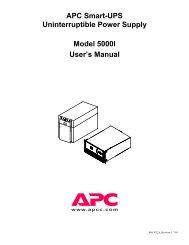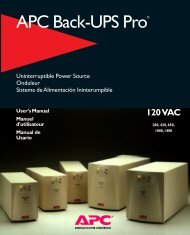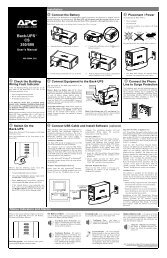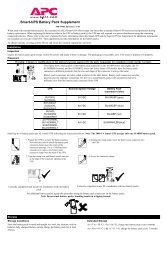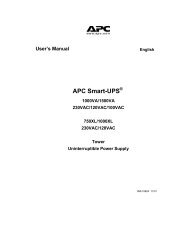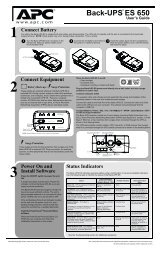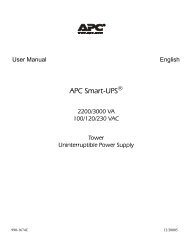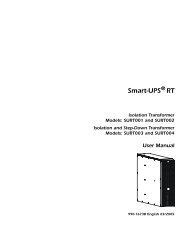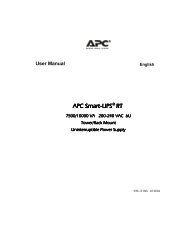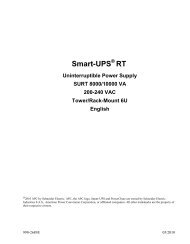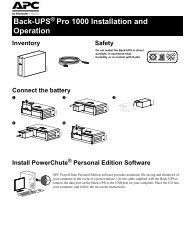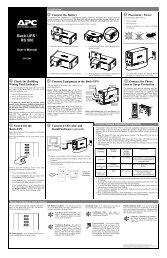APC Smart-UPS SC 1500 SC1500 User's Manual - ExcessUPS
APC Smart-UPS SC 1500 SC1500 User's Manual - ExcessUPS
APC Smart-UPS SC 1500 SC1500 User's Manual - ExcessUPS
You also want an ePaper? Increase the reach of your titles
YUMPU automatically turns print PDFs into web optimized ePapers that Google loves.
User <strong>Manual</strong> English<br />
<strong>APC</strong> <strong>Smart</strong>-<strong>UPS</strong> ® <strong>SC</strong><br />
1000/<strong>1500</strong> VA<br />
110/120/230 Vac<br />
Tower/Rack-Mount 2U<br />
Uninterruptible Power Supply<br />
990-1851D 03/2007
Introduction<br />
The <strong>APC</strong> Uninterruptible Power Supply (<strong>UPS</strong>) is designed to prevent blackouts, brownouts, sags,<br />
and surges from reaching your equipment. The uninterruptible power supply (<strong>UPS</strong>) filters small utility<br />
line fluctuations and isolates your equipment from large disturbances by internally disconnecting<br />
from the utility line. The <strong>UPS</strong> provides continuous power from its internal battery until the utility<br />
line returns to safe levels or the battery is fully discharged.<br />
1: INSTALLATION<br />
Unpack<br />
Attention: Read the safety instruction sheet before installation.<br />
Inspect the <strong>UPS</strong> upon receipt. Notify the carrier and dealer if there is damage.<br />
The packaging is recyclable; save it for reuse or dispose of it properly.<br />
Check the package contents:<br />
Attention: The <strong>UPS</strong> comes with battery disconnected.<br />
<strong>UPS</strong><br />
<strong>UPS</strong> literature kit containing:<br />
Product documentation, safety and warranty information<br />
<strong>Smart</strong>-<strong>UPS</strong> ® User <strong>Manual</strong>s CD<br />
PowerChute Business Edition ® CD<br />
Serial communication cable<br />
Rack-mounting hardware<br />
230 V models: Two jumper cables<br />
Position the <strong>UPS</strong><br />
1
Tower Configuration<br />
Note: Illustrations in this document may appear different than the actual hardware.<br />
<br />
<br />
Mount the <strong>UPS</strong> in a Two-Post Rack<br />
Remove battery bracket screws, battery<br />
bracket, and battery.<br />
2
Note: For information on the four-post rackmounting<br />
kit, see www.apc.com.<br />
Reinstall battery, battery bracket, and screws. <br />
3
2: START UP<br />
Connect Equipment to the <strong>UPS</strong><br />
Rear Panels<br />
110/120 V:<br />
230 V:<br />
• Note: A laser printer draws significantly more power than other types of equipment and may<br />
overload the <strong>UPS</strong>.<br />
Connect the <strong>UPS</strong> to the Network (if Applicable)<br />
Network Connectors<br />
Serial Port<br />
Modem/Telephone/Fax<br />
Ports<br />
Network Surge<br />
Suppression Ports<br />
Use only interface kits approved by <strong>APC</strong>.<br />
Use only the supplied cable to connect to the Serial Port. A standard serial interface cable is incompatible<br />
with the <strong>UPS</strong>.<br />
The <strong>UPS</strong> features modem/telephone/fax surge suppression ports. Connect a single modem/telephone/fax<br />
line into the RJ-11 modem/telephone/fax surge protection IN jack on the back of<br />
the <strong>UPS</strong>. Use telephone cabling (not supplied) to connect the OUT jack to a modem/telephone/fax<br />
port.<br />
The <strong>UPS</strong> also features network surge suppression. Connect a single line 10 Base-T/ 100 Base-Tx<br />
network cable into the RJ-45 network surge protection IN jack on the back of the <strong>UPS</strong>. Use network<br />
cabling (not supplied) to connect the OUT jack to a network port.<br />
4
Start the <strong>UPS</strong><br />
1. Plug the <strong>UPS</strong> into a two-pole, three-wire, grounded receptacle only. Avoid using extension<br />
cords. 110/120 V models: The power cord is attached to the <strong>UPS</strong>. The input plug is a NEMA 5-<br />
15P. 230 V models: The power cord is supplied in the <strong>UPS</strong> literature kit.<br />
2. 110/120 V models: Check the site wiring fault LED located on the rear panel. It will be illu-<br />
3.<br />
minated if the <strong>UPS</strong> is plugged into an improperly wired utility power outlet (see Troubleshooting).<br />
Turn on all connected equipment. To use the <strong>UPS</strong> as a master on/off switch, be sure all connected<br />
equipment is on.<br />
4. Press the button on the front panel to power the <strong>UPS</strong>.<br />
Note: The battery charges fully during the first four hours of normal operation. Do not expect<br />
full battery run capability during this initial charge period. Refer to www.apc.com for on battery<br />
runtimes.<br />
5. For optimal computer system protection, install PowerChute Business Edition management software<br />
to fully configure <strong>UPS</strong> shutdown and alarm settings.<br />
5
3: OPERATION<br />
INDICATOR DE<strong>SC</strong>RIPTION<br />
On Line<br />
On Battery<br />
Overload<br />
Replace Battery/<br />
Battery Disconnected<br />
FEATURE FUNCTION<br />
Power On<br />
Front Display Panel<br />
110/120 V 230 V<br />
The <strong>UPS</strong> is supplying utility power to the connected equipment.<br />
The <strong>UPS</strong> is supplying battery power to the connected equipment.<br />
The connected loads are drawing more than the <strong>UPS</strong> power rating.<br />
The battery is disconnected or must be replaced.<br />
Press this button to turn the <strong>UPS</strong> on or off. (Read on for additional capabilities.)<br />
Self-Test The <strong>UPS</strong> performs a self-test automatically when turned on, and every two<br />
weeks thereafter (by default). During the self-test, the <strong>UPS</strong> briefly operates the<br />
connected equipment on battery.<br />
Cold Start Supply battery power to the <strong>UPS</strong> and connected equipment in the absence of<br />
utility voltage (see Troubleshooting). Press the button for one second and<br />
release. The <strong>UPS</strong> will beep briefly and go quiet. Press and hold the button again,<br />
but for approximately three seconds. The unit will emit a sustained beep. Release<br />
the button during this beep.<br />
6
4: USER CONFIGURABLE ITEMS<br />
FUNCTION<br />
NOTE: SETTINGS ARE ADJUSTED THROUGH POWERCHUTE SOFTWARE<br />
FACTORY<br />
DEFAULT<br />
Self-Test Every 14 days<br />
(336 hours)<br />
USER SELECTABLE<br />
CHOICES<br />
Every 7 days<br />
(168 hours),<br />
Every 14 days<br />
(336 hours),<br />
On Startup Only,<br />
No Self-Test<br />
<strong>UPS</strong> ID <strong>UPS</strong>_IDEN Up to eight characters<br />
(alphanumeric)<br />
Date of Last<br />
Battery<br />
Replacement<br />
Minimum Capacity<br />
Before Return from<br />
Shutdown<br />
Voltage Sensitivity<br />
The <strong>UPS</strong> detects<br />
and reacts to line<br />
voltage distortions<br />
by transferring to<br />
battery operation to<br />
protect connected<br />
equipment.<br />
Alarm Delay After<br />
Line Fail<br />
7<br />
DE<strong>SC</strong>RIPTION<br />
Set the interval at which the <strong>UPS</strong> will<br />
execute a self-test.<br />
Uniquely identify the <strong>UPS</strong>, (i.e. server<br />
name or location) for network management<br />
purposes.<br />
Manufacture Date mm/dd/yy Reset this date when you replace the<br />
battery module.<br />
0 percent 0, 15, 50, 90 percent Specify the percentage to which batteries<br />
will be charged following a lowbattery<br />
shutdown before powering<br />
connected equipment.<br />
High High sensitivity,<br />
Medium sensitivity,<br />
Low sensitivity<br />
5 seconds 5 second delay,<br />
30 second delay,<br />
At low battery<br />
condition,<br />
No alarm<br />
Shutdown Delay 60 seconds 60, 180, 300, 600<br />
seconds<br />
Note: In situations of poor power quality,<br />
the <strong>UPS</strong> may frequently transfer to<br />
battery operation. If the connected<br />
equipment can operate normally under<br />
such conditions, reduce the sensitivity<br />
setting to conserve battery capacity<br />
and service life.<br />
Set the delay to avoid alarms for minor<br />
power glitches.<br />
Set the interval between the time when<br />
the <strong>UPS</strong> receives a shutdown command<br />
and the actual shutdown.
FUNCTION<br />
Low Battery<br />
Warning<br />
Synchronized<br />
Turn-on Delay<br />
High Transfer<br />
Point<br />
NOTE: SETTINGS ARE ADJUSTED THROUGH POWERCHUTE SOFTWARE<br />
FACTORY<br />
DEFAULT<br />
2 minutes<br />
PowerChute<br />
Business Edition<br />
software provides<br />
automatic, unattended<br />
shutdown<br />
when approximately<br />
2 minutes<br />
of battery operated<br />
runtime remains.<br />
USER SELECTABLE<br />
CHOICES<br />
2, 5, 7, 10 minutes<br />
(Times are approximate.)<br />
8<br />
DE<strong>SC</strong>RIPTION<br />
The <strong>UPS</strong> will beep when 2 minutes of<br />
battery runtime remains.<br />
Change the low battery warning interval<br />
setting to the time that the operating<br />
system or system software requires<br />
to safely shut down.<br />
0 seconds 0, 15, 45, 75 seconds Specify the time the <strong>UPS</strong> will wait<br />
after the return of utility power before<br />
turn-on (to avoid branch circuit overload).<br />
110/120 V model:<br />
127 Vac<br />
230 V model:<br />
253 Vac<br />
Low Transfer Point 110/120 V model:<br />
106 Vac<br />
230 V model:<br />
208 Vac<br />
110/120 V model:<br />
127, 130, 133, 136<br />
Vac<br />
230 V model:<br />
253, 257, 261, 265<br />
Vac<br />
110/120 V model:<br />
97, 100, 103, 106<br />
Vac<br />
230 V model:<br />
196, 200, 204, 208<br />
Vac<br />
Set the high transfer point higher to<br />
avoid unnecessary battery usage when<br />
the utility voltage is usually high and<br />
the connected equipment is specified<br />
to operate with input voltages this<br />
high.<br />
Set the low transfer point lower when<br />
the utility voltage is usually low and<br />
the connected equipment is specified<br />
to operate with input voltages this low.
5: STORAGE AND MAINTENANCE<br />
Storage<br />
Store the <strong>UPS</strong> covered in a cool, dry location, with the battery fully charged.<br />
At -15 to +30 °C (+5 to +86 °F), charge the <strong>UPS</strong> battery every six months.<br />
At +30 to +45 °C (+86 to +113 °F), charge the <strong>UPS</strong> battery every three months.<br />
Battery Replacement<br />
The <strong>UPS</strong> battery life differs based on usage and environment. Consider replacing the battery every three years.<br />
This <strong>UPS</strong> has an easy to replace, hot-swappable battery. Replacement is a safe procedure, isolated from electrical<br />
hazards. You may leave the <strong>UPS</strong> and connected equipment on during the replacement procedure. See your<br />
dealer or contact <strong>APC</strong> (see Contact Information) for information on replacement batteries.<br />
Note: Upon battery disconnection, equipment is not protected from power outages.<br />
For the battery replacement procedure, refer to applicable steps in Mount the <strong>UPS</strong> in a Rack.<br />
Be sure to deliver the spent battery to a recycling facility or ship it to <strong>APC</strong> in the replacement<br />
battery packing material.<br />
9
6: TROUBLESHOOTING, SHIPPING, AND SERVICE<br />
Use the chart below to solve minor <strong>UPS</strong> installation and operation problems. Refer to www.apc.com<br />
with complex <strong>UPS</strong> problems.<br />
PROBLEM AND/OR POSSIBLE<br />
CAUSE<br />
<strong>UPS</strong> WILL NOT TURN ON<br />
<strong>UPS</strong> not connected to utility<br />
power supply.<br />
Battery not connected properly.<br />
10<br />
SOLUTION<br />
Check that the power cord from the <strong>UPS</strong> to the utility power supply is securely<br />
connected at both ends.<br />
Ensure that the battery is properly connected.<br />
Very low or no utility voltage. Check the utility power supply to the <strong>UPS</strong> by plugging in a table lamp. If the<br />
light is very dim, have the utility voltage checked.<br />
<strong>UPS</strong> WILL NOT TURN OFF<br />
Internal <strong>UPS</strong> fault. Do not attempt to use the <strong>UPS</strong>. Unplug the <strong>UPS</strong>, disconnect the battery, and<br />
have it serviced immediately.<br />
<strong>UPS</strong> BEEPS OCCASIONALLY<br />
Normal operating <strong>UPS</strong> beeps<br />
when running on battery.<br />
<strong>UPS</strong> IS NOT PROVIDING EXPECTED BACKUP TIME<br />
The <strong>UPS</strong> battery is weak due<br />
to a recent outage or is near<br />
the end of the service life.<br />
None. The <strong>UPS</strong> is protecting the connected equipment from occasional utility<br />
power irregularities.<br />
Charge the battery. Batteries require recharging after extended outages, and<br />
wear faster when frequently put into service or when operated at elevated<br />
temperatures. If the battery is near the end of the service life, consider replacing<br />
even if the replace battery LED is not yet illuminated.<br />
ON-LINE AND OVERLOAD LEDS ARE FLASHING ALTERNATELY<br />
The <strong>UPS</strong> was shut down None. The <strong>UPS</strong> will restart when utility power returns.<br />
through PowerChute.<br />
ON-LINE AND ON-BATTERY LEDS ARE FLASHING, OR, OVERLOAD LED IS FLASHING<br />
Internal <strong>UPS</strong> fault. The <strong>UPS</strong><br />
has shut down.<br />
Do not attempt to use the <strong>UPS</strong>. Turn off the <strong>UPS</strong>, unplug the battery, and<br />
have it serviced immediately.<br />
ALL LEDS ARE OFF AND THE <strong>UPS</strong> IS PLUGGED INTO A WALL OUTLET<br />
The <strong>UPS</strong> is shut down or the<br />
battery is discharged from an<br />
extended outage.<br />
None. The <strong>UPS</strong> will return to normal operation when the power is restored<br />
and the battery has a sufficient charge.
PROBLEM AND/OR POSSIBLE<br />
CAUSE<br />
11<br />
SOLUTION<br />
THE OVERLOAD LED IS ILLUMINATED AND THE <strong>UPS</strong> EMITS A SUSTAINED ALARM TONE<br />
The <strong>UPS</strong> is overloaded. The The connected equipment exceeds the specified “maximum load.”<br />
connected equipment is draw-<br />
The alarm remains on until the overload is removed. Disconnect nonessening<br />
more VA than the <strong>UPS</strong> can<br />
tial equipment from the <strong>UPS</strong> to eliminate the overload.<br />
sustain.<br />
The <strong>UPS</strong> continues to supply power as long as it is on-line and the circuit<br />
breaker does not trip; the <strong>UPS</strong> will not provide power from batteries in the<br />
event of a utility voltage interruption.<br />
If a continuous overload occurs while the <strong>UPS</strong> is on battery, the unit turns<br />
off output in order to protect the <strong>UPS</strong> from possible damage.<br />
THE REPLACE BATTERY/BATTERY DI<strong>SC</strong>ONNECTED LED IS ILLUMINATED<br />
This LED flashes and a short Check that the battery connector is fully engaged.<br />
beep is emitted every two seconds<br />
to indicate the battery is<br />
disconnected.<br />
Weak battery. Allow the battery to recharge for 24 hours. Then, perform a self-test. If the<br />
problem persists after recharging, replace the battery.<br />
Failure of a battery self-test. The <strong>UPS</strong> emits short beeps for one minute and the replace battery LED<br />
illuminates. The <strong>UPS</strong> repeats the alarm every five hours. Perform the selftest<br />
procedure after the battery has charged for 24 hours to confirm the<br />
replace battery condition. The alarm stops and the LED clears if the battery<br />
passes the self-test.<br />
THE SITE WIRING FAULT LED ON THE REAR PANEL IS ILLUMINATED (110/120 V MODEL ONLY)<br />
The <strong>UPS</strong> is plugged into an<br />
improperly wired utility power<br />
outlet.<br />
THE INPUT CIRCUIT BREAKER HAS TRIPPED<br />
The <strong>UPS</strong> is overloaded. The<br />
plunger on the circuit breaker<br />
has popped out.<br />
Wiring faults detected include missing ground, hot-neutral polarity reversal,<br />
and overloaded neutral circuit.<br />
Contact a qualified electrician to correct the building wiring.<br />
Reduce the load on the <strong>UPS</strong> by unplugging equipment. Press in the plunger<br />
on the circuit breaker.<br />
<strong>UPS</strong> OPERATES ON BATTERY ALTHOUGH UTILITY VOLTAGE EXISTS<br />
The <strong>UPS</strong> input circuit breaker<br />
has tripped.<br />
The line voltage is very high,<br />
low or distorted.<br />
ON-LINE LED<br />
To reduce the load on the <strong>UPS</strong>, unplug equipment and press in the plunger<br />
on the circuit breaker.<br />
Move the <strong>UPS</strong> to a different outlet on a different circuit, as inexpensive fuel<br />
powered generators may distort the voltage. If acceptable to the connected<br />
equipment, reduce the <strong>UPS</strong> sensitivity (see User Configurable Items).<br />
There is no illumination. The <strong>UPS</strong> is running on battery, or it must be turned on.<br />
The LED is blinking. The <strong>UPS</strong> is running an internal self-test.
Shipping and Service<br />
Prepare the <strong>UPS</strong> for shipping:<br />
Shutdown and disconnect any equipment attached to the <strong>UPS</strong>. Shut down the <strong>UPS</strong>, and disconnect<br />
the <strong>UPS</strong> from the utility power outlet. Disconnect the battery.<br />
If the <strong>UPS</strong> requires service do not return it to the dealer. Follow these steps:<br />
1. Review the problems discussed in Troubleshooting to eliminate common problems.<br />
2. If the problem persists, contact <strong>APC</strong> Customer Service through the <strong>APC</strong> web site, www.apc.com/support.<br />
Note the model number of the <strong>UPS</strong>, the serial number, and the date purchased. If you call <strong>APC</strong> Customer<br />
Service, a technician will ask you to describe the problem and attempt to solve it over the phone.<br />
If this is not possible, the technician will issue a Returned Material Authorization Number (RMA#).<br />
If the <strong>UPS</strong> is under warranty, repairs are free.<br />
3. Pack the <strong>UPS</strong> in its original packaging. If this is not available, refer to www.apc.com/support for information<br />
about obtaining a new set.<br />
Pack the <strong>UPS</strong> properly to avoid damage in transit. Never use Styrofoam beads for packaging. Damage<br />
sustained in transit is not covered under warranty.<br />
Always DI<strong>SC</strong>ONNECT THE BATTERY before shipping in compliance with U.S. Department of<br />
Transportation (DOT), and IATA regulations. The battery module(s) may remain in the <strong>UPS</strong>; it<br />
does not have to be removed.<br />
4. Mark the RMA# on the outside of the package.<br />
5. Return the <strong>UPS</strong> by insured, prepaid carrier to the address given to you by Customer Service.<br />
Contact Information<br />
U.S. Customers - Refer to www.apc.com/support.<br />
International Customers - Refer to www.apc.com, select the appropriate country from the country selection<br />
field, and select the Support tab at the top of the web page.<br />
12
7: REGULATORY AND WARRANTY INFORMATION<br />
110/120 V models<br />
This equipment has been tested and found to comply with the limits for a Class A digital device, pursuant<br />
to part 15 of the FCC Rules. These limits are designed to provide reasonable protection against<br />
harmful interference when the equipment is operated in a commercial environment. This equipment<br />
generates, uses, and can radiate radio frequency energy and, if not installed and used in accordance<br />
with the instruction manual, may cause harmful interference to radio communications. Operation of<br />
this equipment in a residential area is likely to cause harmful interference in which case the user will<br />
be required to correct the interference at his/her own expense.<br />
Shielded signal cables must be used with this product to ensure compliance with the Class A FCC<br />
limits.<br />
230 V models<br />
This is a Class A product. In a domestic environment this product may cause radio interference, in<br />
which case the user may be required to take corrective actions.<br />
13
Limited Warranty<br />
American Power Conversion (<strong>APC</strong>) warrants its products to be free from defects in materials and workmanship<br />
for a period of two years from the date of purchase. Its obligation under this warranty is limited to repairing or<br />
replacing, at its own sole option, any such defective products. To obtain service under warranty you must obtain<br />
a Returned Material Authorization (RMA) number from customer support. Products must be returned with<br />
transportation charges prepaid and must be accompanied by a brief description of the problem encountered and<br />
proof of date and place of purchase. This warranty does not apply to equipment that has been damaged by accident,<br />
negligence, or misapplication or has been altered or modified in any way. This warranty applies only to the<br />
original purchaser who must have properly registered the product within 10 days of purchase.<br />
EXCEPT AS PROVIDED HEREIN, AMERICAN POWER CONVERSION MAKES NO WARRANTIES,<br />
EXPRESSED OR IMPLIED, INCLUDING WARRANTIES OF MERCHANTABILITY AND FITNESS FOR<br />
A PARTICULAR PURPOSE. Some states do not permit limitation or exclusion of implied warranties; therefore,<br />
the aforesaid limitation(s) or exclusion(s) may not apply to the purchaser.<br />
EXCEPT AS PROVIDED ABOVE, IN NO EVENT WILL <strong>APC</strong> BE LIABLE FOR DIRECT, INDIRECT,<br />
SPECIAL, INCIDENTAL, OR CONSEQUENTIAL DAMAGES ARISING OUT OF THE USE OF THIS<br />
PRODUCT, EVEN IF ADVISED OF THE POSSIBILITY OF SUCH DAMAGE. Specifically, <strong>APC</strong> is not liable<br />
for any costs, such as lost profits or revenue, loss of equipment, loss of use of equipment, loss of software,<br />
loss of data, costs of substitutes, claims by third parties, or otherwise.<br />
Entire contents copyright 2005 by American Power Conversion Corporation. All rights reserved.<br />
Reproduction in whole or in part without permission is prohibited.<br />
<strong>APC</strong>, the <strong>APC</strong> logo, <strong>Smart</strong>-<strong>UPS</strong>, and PowerChute are registered trademarks of American Power<br />
Conversion Corporation. All other trademarks are the property of their respective owners.<br />
14



